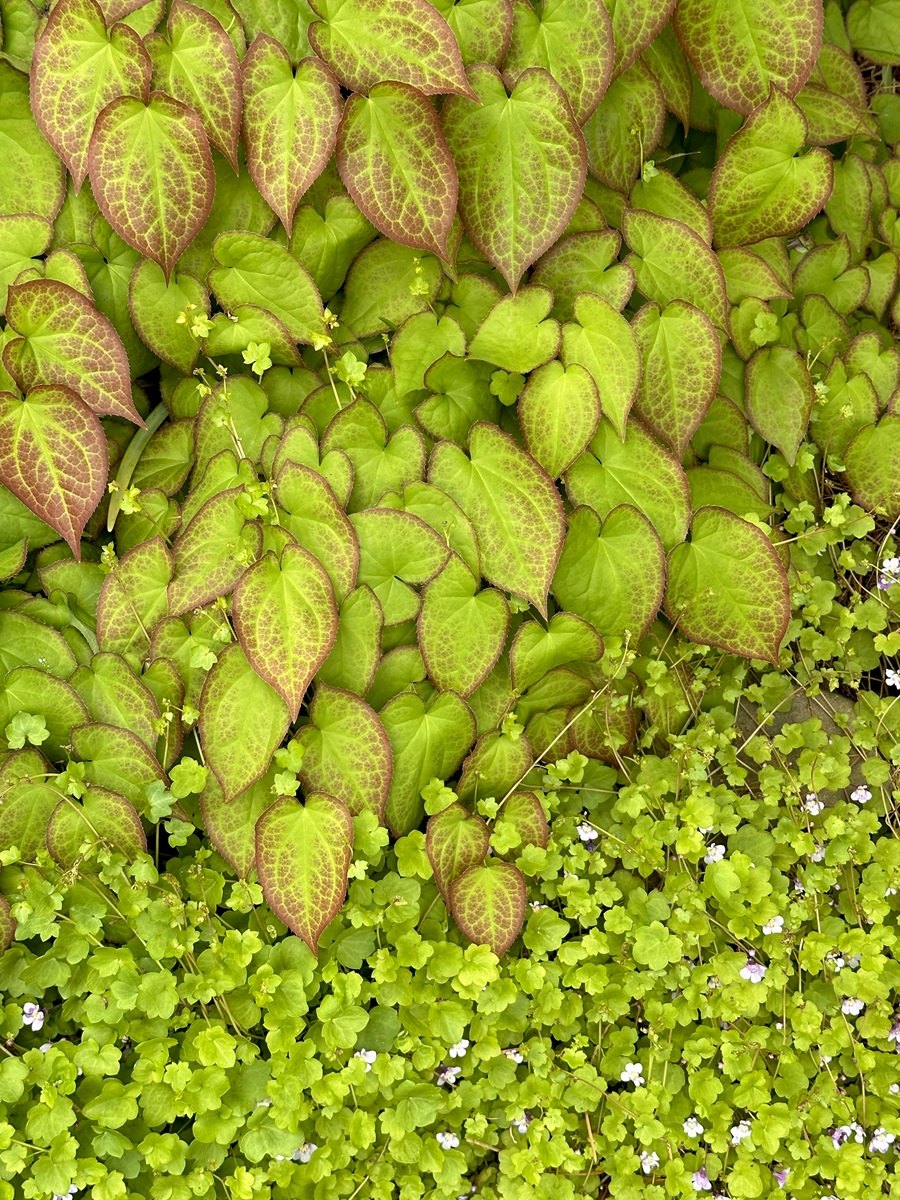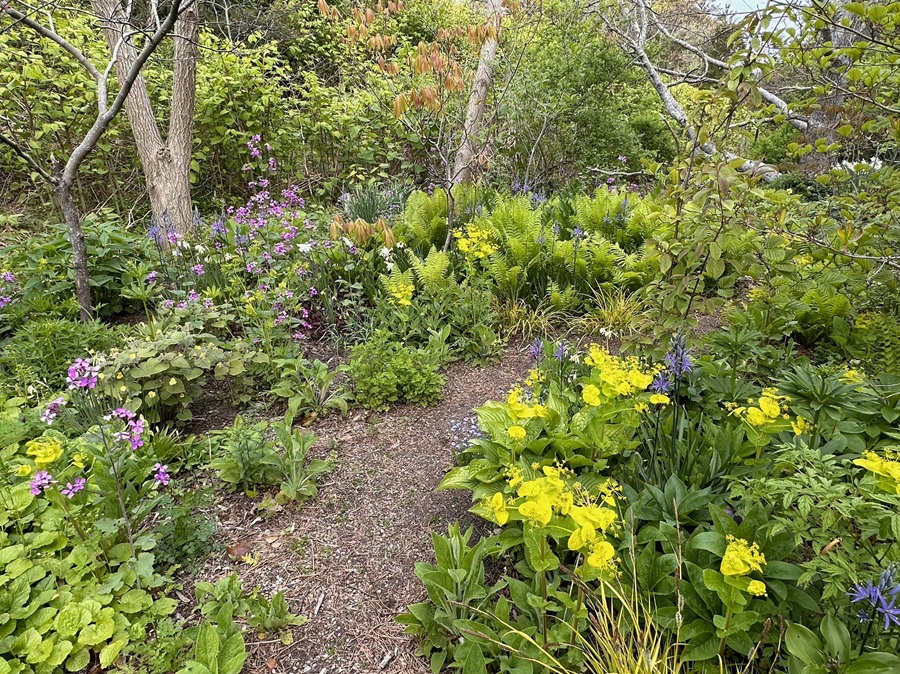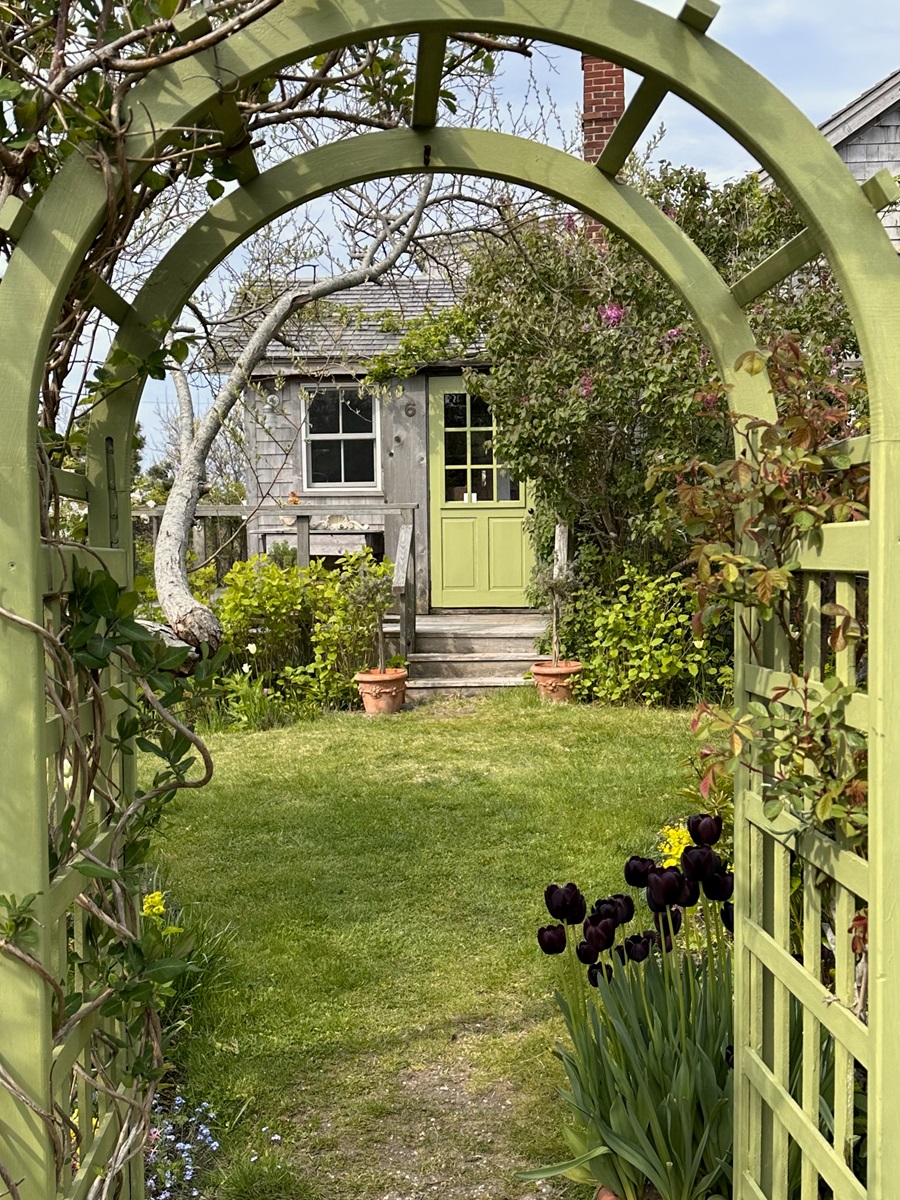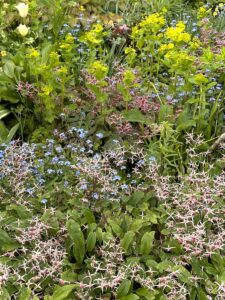Hidden behind a rustic wooden fence tiny spring treasures abound: Nodding bluebells, arching ferns, dainty forget-me-nots, and self-sown alexanders in a glowing shade of chartreuse, all knitted together like a tapestry. This exposed seaside location above Cold Storage Beach in Truro is hardly the spot where you’d expect to find a jewel box of delicate spring ephemerals tucked underneath the rough cedars, but here they are.

Anyone who has walked Outer Cape Cod’s bay beaches knows that they can be serene and balmy one day and swept by sandblasting winds the next. Most gardeners in such a location stick to the tried and true: rugosa roses, grasses, beach plums, pitch pines, and oaks. But David Kirchner and his partner, Scott Warner, are not like most. Over several decades, they have been perfecting a sloping garden that yields to the reality of this windy spot while pushing the envelope of what can be grown in a mercurial marine environment.

When Kirchner bought a house here over 30 years ago, the existing garden included roses and hydrangeas surrounded by the usual Outer Cape tangle of bush honeysuckle, bittersweet, and black locust. Though he had never gardened before, he jumped right in by carving a series of flower beds out of the rough lawn and filling them with garden soil and compost. He was on a mission to find out the range of plants that would grow on what is basically a dune, nearly 50 feet above the waves.

Ten years later, when he and Warner bought the house next door, the pair took down the fences, added more beds, and knitted the two lots together with plantings. The resulting three-quarter-acre cottage garden now surrounds two 19th-century cottages, which Kirchner conjectures were used for worker housing by those working the fishing weirs below. Rambling roses such as ‘Paul’s Himalayan Musk’ and ‘Rambling Rector’ claw their way up 30 feet into the trees while a well-timed display of bulbs, perennials, and self-sown annuals launch a floral parade that lasts from early spring to late autumn. A woodland garden, created after a septic system upgrade in 2013, sits partway down the hill along the bed of the former railroad that ran along the embankment all the way to Provincetown.
The garden has been a place of experimentation ever since, with a list of successes that takes less time to name than the failures.
The Ways of the Wind
The main challenge is also the most obvious. “We have wind here most of the time,” says Kirchner. “It can be very problematic. We’re so exposed, and it can come from any direction.” The price of the expansive views off to Provincetown is the prevailing winds that travel over the water. “The houses create wind blocks,” says Kirchner. “That’s why the garden is on the road side of the property and not on the bay side.” But the wind can never be tamed entirely. Nor’easters define the winters, while strong winds blow from the southwest in the summers.

The other challenge is the soil, which is almost pure sand. Warner and Kirchner can easily list from memory the plants that like the sharp drainage and decide to stay and the ones that prefer richer soil and pull a disappearing act after their first year. Because of the lack of organic matter, compost and soil can easily wash down through the grit; it needs to be replenished every few years. “You can tell when the soil is giving out,” says Warner. “The plants let you know.”

Watering is done by hand rather than with an automated system — it’s more precise that way. But by August, there can be casualties. Even though this spot is by most measures idyllic for humans, horticulturally speaking it is a survival-of-the-fittest situation, with every plant having to pull its own weight.
Plants That Earn Their Places

Roses make the cut, but not every variety succeeds. They have to be tough enough to withstand the wind while tolerating often dry conditions. Ramblers such as ‘Appleblossom’ and ‘Baltimore Belle’ bloom prolifically over arches and through trees. Warner favors single-petaled varieties like the species Father Hugo (Rosa hugonis) so that pollinators can easily access their nectar and pollen.
The gardeners don’t always agree about which plants earn a spot in the garden and which do not. “I regret ever planting Thérèse Bugnet,” says Warner of the well-known rugosa. “It’s completely taking over the bed and the lawn with its suckers.”
“Oh, but its red stems are so pretty in winter,” Kirchner counters. To which Warner replies, “The flowers ball and never open.” Kirchner adds one last note: “Well, it smells really nice.” Like any good relationship, gardening is all about compromise.
Plants that self-sow somewhat aggressively but not invasively are welcomed since they provide a baseline of flowers that return year after year. Their habit of turning up where they want to instead of where they were first sown lends the kind of randomized charm that defines cottage gardens. Especially in spring, when annuals and biennials such as honesty, patrinia, alexanders, white corydalis, rose campion, and coral spurge weave through various beds.

Taller self-seeders like foxgloves, Greek mullein (Verbascum olympicum), and Verbena bonariensis form graceful spires, punctuating the property with waving wands in the coastal breezes. “To me, foxgloves are the ultimate cottage garden flower,” says Kirchner of the tall biennial with its nodding, bell-shaped blossoms.
Thinking Forward
As with any garden, this one is never finished. The lower woodland garden, once sunny before the cedars and black locust filled in, is now getting shadier, so the planting will need some adjusting. “I like the opportunity to have the woodland plants down there,” says Warner. “And since many of the trees are deciduous it works out that they can get the early spring sun.

“Our theory now is, these are the things that like it here so let them grow,” he says, “rather than struggling against the inevitable demise of plants that aren’t happy.” Unsuccessful experiments include astrantia, winter hazel, larkspurs, cardoons, and lilies, the last decimated by the lily leaf beetle. Broad-leaved evergreens hate the winter winds. After a good start, hollyhocks developed leaf rust and are now out of the picture. Rabbits mow down their crocuses. Water-loving plants like cardinal flower and Japanese iris need more moisture than the sandy location can offer. “Hundreds of plants have croaked,” Warner says. “Sometimes, things just don’t like you and I’m fine with that.”

So why try? Maybe a garden in a spot where many people would be happy with carefree dune grasses and an astonishing water view is just quixotic. These two have answers. “The husbandry of plants is just inherently satisfying to me,” says Warner. “It’s a creative outlet, and it’s also good to be outside.”
For Kirchner, a garden is about the future. “Right now, just knowing I can walk out and see the first spring flowers,” he says, his eyes scanning the land. “It keeps you thinking forward and not backward.”
“Spring never ceases to amaze me,” says Warner. “That this is actually happening. These flowers. This greenery. It’s a miracle that enthralled me as a child and has never ceased.”



